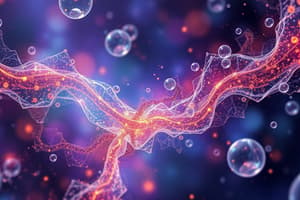Podcast
Questions and Answers
What percentage of the human body weight is made up of water?
What percentage of the human body weight is made up of water?
60-75%
What happens if you lose 4% of water content in your body?
What happens if you lose 4% of water content in your body?
- dehydration (correct)
- fatal
- superhydration
- normal
What kind of bond is a polar covalent bond?
What kind of bond is a polar covalent bond?
Extensive capability to dissolve a variety of molecules
Sugars are non-polar.
Sugars are non-polar.
What creates pressure inside the cell?
What creates pressure inside the cell?
What is a hydrated cell?
What is a hydrated cell?
What happens to a dehydrated cell?
What happens to a dehydrated cell?
What do heads of phospholipids interact with?
What do heads of phospholipids interact with?
What do tails of phospholipids avoid?
What do tails of phospholipids avoid?
What type of cell component allows some molecules to enter and exit whilst excluding others?
What type of cell component allows some molecules to enter and exit whilst excluding others?
What happens if you lack water during a chemical reaction?
What happens if you lack water during a chemical reaction?
What is water's role in the function of proteins?
What is water's role in the function of proteins?
What do proteins turn into?
What do proteins turn into?
If concentration of outside H2O inside?
If concentration of outside H2O inside?
What happens when water moves out of the cell?
What happens when water moves out of the cell?
What is the function of active transport in the paramecium or single cell?
What is the function of active transport in the paramecium or single cell?
What is osmosis?
What is osmosis?
If external is greater than the internal, the cell is?
If external is greater than the internal, the cell is?
Flashcards
Osmosis
Osmosis
Movement of water from high to low concentration through a semipermeable membrane.
Homeostasis
Homeostasis
Tendency to maintain a stable internal environment despite external changes.
Passive Transport
Passive Transport
Transport that doesn't require energy.
Diffusion
Diffusion
Signup and view all the flashcards
Isotonic Solution
Isotonic Solution
Signup and view all the flashcards
Hypertonic Solution
Hypertonic Solution
Signup and view all the flashcards
Hypotonic Solution
Hypotonic Solution
Signup and view all the flashcards
Universal Solvent
Universal Solvent
Signup and view all the flashcards
Cohesion
Cohesion
Signup and view all the flashcards
Turgor Pressure
Turgor Pressure
Signup and view all the flashcards
Mucociliary System
Mucociliary System
Signup and view all the flashcards
Cystic Fibrosis
Cystic Fibrosis
Signup and view all the flashcards
Prokaryotic Cells
Prokaryotic Cells
Signup and view all the flashcards
Eukaryotic Cells
Eukaryotic Cells
Signup and view all the flashcards
Cytoplasm
Cytoplasm
Signup and view all the flashcards
Cytoskeleton
Cytoskeleton
Signup and view all the flashcards
Ribosomes
Ribosomes
Signup and view all the flashcards
Endoplasmic Reticulum (ER)
Endoplasmic Reticulum (ER)
Signup and view all the flashcards
Golgi Apparatus
Golgi Apparatus
Signup and view all the flashcards
Lysosomes
Lysosomes
Signup and view all the flashcards
Vacuole
Vacuole
Signup and view all the flashcards
Mitochondria
Mitochondria
Signup and view all the flashcards
Nucleus
Nucleus
Signup and view all the flashcards
Plasma membrane
Plasma membrane
Signup and view all the flashcards
Cell Wall
Cell Wall
Signup and view all the flashcards
Chloroplasts
Chloroplasts
Signup and view all the flashcards
Xylem
Xylem
Signup and view all the flashcards
Phloem
Phloem
Signup and view all the flashcards
Stomata
Stomata
Signup and view all the flashcards
Multinucleated
Multinucleated
Signup and view all the flashcards
Concentration Gradient
Concentration Gradient
Signup and view all the flashcards
Solute
Solute
Signup and view all the flashcards
Solution
Solution
Signup and view all the flashcards
H2O
H2O
Signup and view all the flashcards
Solvent
Solvent
Signup and view all the flashcards
Human Body Water
Human Body Water
Signup and view all the flashcards
Polarity
Polarity
Signup and view all the flashcards
Cell Pressure
Cell Pressure
Signup and view all the flashcards
Phospholipid Bilayers
Phospholipid Bilayers
Signup and view all the flashcards
Proteins
Proteins
Signup and view all the flashcards
Catalyze Chemical Reactions
Catalyze Chemical Reactions
Signup and view all the flashcards
DNA
DNA
Signup and view all the flashcards
Photosynthesis
Photosynthesis
Signup and view all the flashcards
Dehydration
Dehydration
Signup and view all the flashcards
Cilia Sweep Mucus
Cilia Sweep Mucus
Signup and view all the flashcards
CFTR
CFTR
Signup and view all the flashcards
Epithelial Sodium Channel
Epithelial Sodium Channel
Signup and view all the flashcards
Prokaryotes
Prokaryotes
Signup and view all the flashcards
Eukaryotes
Eukaryotes
Signup and view all the flashcards
Characteristics of Cells
Characteristics of Cells
Signup and view all the flashcards
Cell Membrane
Cell Membrane
Signup and view all the flashcards
Endoplasmic Reticulum
Endoplasmic Reticulum
Signup and view all the flashcards
Study Notes
Diffusion and Osmosis
- When a solution needs to be diluted, water flows from an area of high water concentration to low water concentration until it achieves the correct solute mixture
- Particle movement is always more to less concentrated
Homeostasis
- Molecules randomly move from high-to-low concentration zones
Solutions
- Solutions move across cells by osmosis
Transport in Cells
- External concentration levels affect the cell's dehydration levels, causing it to crenate/shrink due to it's lower level outside
- Normal external levels will result in solute that remains consistent through out the cell
- If external water concentrations are higher than normal it could cause bloat or damage the cell
- Osmosis is the movement of molecules across a cell, the form of diffusion
Water's Composition
- Polar Covalent Bonds involve adjacent cohesion where water molecules stick together
Cellular Water and Shape
- Osmosis releases water during hypotonic concentrations
Prokaryotic vs. Eukaryotic Cells
- Eukaryortic calls have Golgi Budy
- Eukaryotic vs Prokaryotic are similar in that they contain lipids carbs, proteins, nucleic acids, ribosomes, metabolism and may even include cell walls
Cell Organelles (Animals)
- The Endoplasmic Reticulum helps pacakge proteins with materials for either immediate use or to be packaged
Cell Walls (Plants)
- Cell walls are semipermiable, which protect the cell, and it all made of cellulous
The Gram Stain
- The Gram Stain helps indentify processes bacteria
- Gram Positive is typically purple in color and can retain its color after dying
- Gram Negatives are readily discolorized, typically red, due to lipid rich membranes.
Bacteria
- Bacteria can synthsize and absorb nutrients in heterotrophic solutions
- Bacterial DNA is more circular and not seperated with Plasmid structures.
- Bacteria can range from rods, shaped into chains/spirals
- Bacteria does binary fisson, or single or direct cell replication
Plant Cells
- Each of the cells must perform different tasks (Stem/Root system, etc)
- Photosynthesis produce sugars from sun and carbon dioxide
- There are also fiber cells provide strength to stem/plants
Plasma Membrane
- Must maintain balance through osmosis
- Protects the cell membrane
- Phospholipids bilayers create semi-permiability
- Must regulate proteins
- They can more around if not hydrophilic to help maintain the proper structure of proteins
Studying That Suits You
Use AI to generate personalized quizzes and flashcards to suit your learning preferences.




